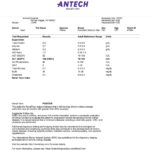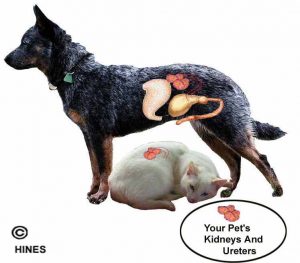Kidney Disease In Your Dog Or Cat
Ron Hines DVM PhD





Bodies suffer the wear and tear of time. In people, our hearts might be our weakest organ. In cats and dogs, it is often kidneys that wear out first. Scientists do not know why, but there is a slow, steady, loss of kidney function as our pets (and us humans age). Chronic renal (kidney) failure is the leading cause of serious illness in older cats and high on the list in dogs as well. In middle age and elderly cats, you can pretty much track the pet’s age by its blood creatinine level.
RenalTech™
In 2020 Antech Diagnostics, a division of Mars Conglomerates saw an opportunity and introduced their RenalTech™ algorithm. It compares your cat’s age with its blood creatinine level and several other blood values and furnishes a decision that they claim to be 95% accurate at predicting when your cat’s kidneys will begin to fail. See an example of that here: 
What Happens When Kidneys Can No Longer Cleans Toxins From My Dog Or Cat’s Body?
First, you need to know something about the work of the kidneys. Kidneys keep your pet’s body free of the wastes that accumulate during normal metabolism. They are continually “scrubbing” your pet’s blood free of excess salts, water and metabolites.
The actual removal of wastes occurs in tiny systems within the kidneys called nephrons. There are almost one million of these structures in a single human kidney. No one has counted them in dogs or cats. Each nephron contains a small sieve-like filtering structures called glomeruli . Healthy glomeruli keep normal blood proteins and blood cells that pass through them in the bloodstream. But extra fluid and wastes pass through their sieve-like structures and end up in your pet’s urine. A complicated chemical exchange takes place, as waste materials and water leave the blood and enter the urinary system. The kidneys also regulate the acidity of your pet’s body. By regulation of body sodium content, they help control blood pressure. Cells associated with healthy nephrons produce an important hormone called erythropoietin and an enzyme called renin. Erythropoietin is necessary for your dog or cat’s body to produce and maintain red blood cells, while renin activates another hormone (angiotensin) to helps control blood pressure. In addition, healthy kidneys process vitamin D3 (calcifediol) into the active form of vitamin D, calcitriol . Healthy kidneys also preserve calcium for bone structure and preserve normal amounts of ionized calcium in your pet’s blood and cells. (read here) Meat is very high in phosphorus and low in calcium. It is your pet’s kidneys job to see to it that the ratio between blood calcium and blood phosphorus stays near 2:1 . In chronic kidney disease these glomeruli are scarred, damaged, lost, or plugged with proteins and inflammatory cells. Without enough functioning glomeruli, none of the processes I mentioned work normally.
But My Pet Is Still Producing Plenty Of Urine – More Than Before!
The body is marvelous in sensing when it has a problem. Within your pet’s brain (hypothalamus) reside sensors that continuously monitor the level of dissolved substances in your cat or dog’s blood. (read here) The primary way to change the concentration of these substances up or down is through your dog or cat’s kidneys. Think of the kidneys as a gatekeeper to adjust body constituents up or down in a variety of ways. When the hypothalamus senses an imbalance, it sends messages to the conscious brain that it is time to drink. (read here) In dogs and cats with reduced kidney function, those neural messages correct the imbalances for a while and account for the increased thirst (polydipsia) and urination (polyuria) that you see in your pet. Kidneys with reduced abilities are running more water-containing blood through their kidneys and in the process producing more urine. The urine is more dilute, but its total volume still keeps your pet’s blood wastes reasonably under control. But over time, with less and less kidney function left, your dog and cat cannot use that method to keep blood wastes in control. As that time approaches your pet is likely to experiences weight loss, anemia, and abnormal blood work results. By that time veterinarians believe that over half of its kidney glomeruli have been lost.
What Are The Signs Of Kidney Disease In Cat And Dog?
The first sign which I already mentioned is when your pet begins to drink water and urinate excessively. That starts slowly. So at first it is quite normal for pet owners to not be aware that a problem is even brewing. It might just be that your dog wakes you up during the night to be let out or that your dog’s water bowl had to be filled more frequently than it used to be. Your might notice that your cat’s litter box seems to be smellier and is staying damp. But you pets look and acts fine – so why drag them in for a checkup. But with time, they begin to loose weight. They become more finicky eater. About the same time, their energy level decreases as well. They are likely to play less, romp less and sleep more. Their coat might lack the luster it once had. But you probably just associate all that to your pet’s advancing age. Unless your veterinarian is doing periodic “wellness” exams on your dog or cat, you are unlikely to be aware of the early stages of kidney disease. The late stages are often the time when pets are first taken by their concerned owner to see their veterinarian. In advanced kidney disease, pets no longer want to eat. You might tempt them with pungent and favorable treats – the the standby diet they ate willing over the years is no longer of interest to them. These pets often have digestive disturbances as well – things such as nausea, drooling retching and diarrhea. They might stand over their water or food bowl without attempting to drink or eat. Their water intake in advanced kidney failure finally decreases and they become dehydrated. These pets might pant do to anemia – toxin buildup in their system is preventing their bone marrow from producing new red blood cells. These pets have all developed uremia – an intolerably high level of nitrogen-containing metabolic waste products in their blood. Veterinarians also refer to the situation as azotemia because these toxic waste products all contain the azo=molecular double bonded grouping of nitrogen.
Why Did This Happen To My Pet And Not To Another Pet Of The Same Age?
Veterinarians know quite a bit about the things that make a dog or cat’s kidneys fail suddenly. But veterinarians are much less certain why kidneys fail gradually. Theories come and go. Many of the proposed causes seem logical – but none of them have been tested and found to be true. Regardless of the cause, all cases of chronic kidney disease develop the same signs and pass through the same stages. Usually, your veterinarian will just tell you your pet has CRF. This is because, in most cases, there is no way for your veterinarian to determine the cause. That said, some veterinarians (me included) are suspicious that cats on dry kibble diets do not consume sufficient water. Their normal rodent prey is about 80% water. So in their wild state, felines have little need to drink. No studies have been done in dogs or cats that linked low water consumption to kidney disease nor were any studies ever done that disproved it. In humans that theory did not hold up in two studies (read here & here) but did in a single published study in rats. (read here) What we feed dogs and cats is not at all what they would eat in their wild state. Humans have adjusted their diets to make them more convenient. But what that has done to their long-term health remains unknown. Read about that here.
The Wear And Tear Of Time
There was a time not so long ago when infectious diseases and dietary deficiencies ended the lives of dogs and cats early. But with advances in pet nutrition, antibiotics and sophisticated surgery, dogs and cats now live much longer lives. Nothing lasts forever and every organism has its weaker links. We were taught that the crucial cells of the kidneys (podocytes) cannot be replaced, divide or regenerate as they do in the liver, lungs, bone and skin. Once a glomerulus ages and is lost, it is lost forever. This is probably the most common cause of kidney failure in dogs and cats. There is a lot of interest in kidney regeneration because humans suffer the same fate.
Polycystic Kidney Disease
Some cats and dogs were destined from birth to loose kidney function abnormally early in life. These pets inherited genes that cause fluid-filled sacks (cysts) to form within their kidneys. As these cysts gradually grow in size, they crowd out and destroy the functional tissue (glomeruli) within the pet’s kidneys. This is an inherited problem in certain purebred cats. It is much less common in dogs, but it does occasionally occur in terriers and beagles.
Chronic Interstitial Nephritis
This term is used less frequently now than it once was. It was coined by pathologists to described what they saw on microscopic slides of the kidney taken from dog and cat that had passed away from kidney failure. Chronic interstitial nephritis is the most common form of kidney damage in older pets. Nephritis mean inflammation of the kidneys. Veterinary pathologists that examine kidney tissue from those pets noticed that they had higher than normal numbers of inflammatory cells (neutrophils and lymphocytes) within and surrounding the glomeruli . This low-grade, chronic inflammation is still thought to be the cause of the scaring that eventually destroys most of the these urine filters. Various theories of possible underlying causes for this low-grade inflammation have been proposed over the years : exposure to leptospirosis organisms. (read here), chronic urinary tract infections (read here), bartonella in cats (read here). But evidence that any of these diseases play a significant roll in the majority of kidney failures in dogs and cat has never been found. Pets suffering from chronic interstitial nephritis have small, shrunken, hard kidneys due to scarring shrinkage. If your pet is not too chubby, your veterinarian can often palpate and identify these shrunken firm kidneys during a routine veterinary exam.
Chronic Over-stimulation Of Your Pet’s Immune System
Your pet’s kidney glomeruli act as a sieve, straining and filtering blood as it passes through it. Very large molecules in the blood have a tendency to collect there and appear to slowly damage the kidney’s filtering-ability. Some of these large molecules are antibodies combined with antigens (immune complexes). Many chronic infectious and auto-immune diseases produce immune complexes. These include Lyme disease, chronic skin infections, chronic intestinal disease , overactive adrenal glands (Cushing’s disease) and diabetes. Chronic gum disease (periodontal disease) is associated with kidney damage in humans. It is associated with heart disease in dogs. We do not yet know if any of these things are a risk factor for kidney disease in pets. Abyssinian and Siamese cats, shar pei and akita dogs all have a higher than normal incidence of amyloidosis which can lead to kidney failure.
Hyperthyroidism In Cats And High Blood Pressure
An overactive thyroid gland or hyperthyroidism has become a very common problem in older cats. Read about hyperthyroidism in cats here. Veterinarians are uncertain why it is occurring more frequently, but we know that it often occurs concurrently with kidney disease. Hyperthyroidism often masks the signs of kidney failure, and it is only when your veterinarian resolves your cat’s thyroid problem that it becomes apparent that the cat’s kidneys are failing. We know that hyperthyroidism may cause your cat’s blood pressure to be abnormally high. We also know that high blood pressure leads to kidney failure. This is probably why hyperthyroidism and kidney failure go hand-in-hand in cats.
Lower Urinary Tract Disease
Feline Urological Syndrome ( FUS ) is another disease that has become very common. In this condition, a pasty grit ( struvite crystals) irritates and sometimes plugs the cat’s urethra, preventing normal urination. When the urethra is partially or completely plugged and the cat cannot pee, urine pressure builds up in the bladder, up the tubes to the kidneys (ureters), and into the kidneys themselves. Abnormally high urine pressure in the kidneys slowly destroys them. The condition is called hydronephrosis. However most cats that loose their normal kidney function do not show the kidney changes associated with hydronephrosis. In dealing with FUS, cats are often placed on diets that are very acidic, in an attempt to prevent struvite crystals from forming. Some veterinarians believe that the acid urine these diets produce is unhealthy for the kidneys and may be one reason that they fail. The pH of these diets has recently been adjusted upward to take this into account.
How Will My Veterinarian Diagnose Kidney Disease In My Pet?
The history you give your veterinarian, your pet’s age and the veterinarian’s physical examination of your pet may make your veterinarian suspect a chronic kidney problem. As kidneys scar, they become hardened, small and lumpy. In lean pets, they have a characteristic feel when felt through the abdominal wall. In these cases, and when a diagnosis is unclear, your veterinarian will run tests. Blood and urine tests that warn of kidney damage are included in all standard laboratory examinations. When your pet feels poorly and the cause is uncertain, these are the first tests your veterinarian will run. See your cat and dog’s normal blood values here .
Your Pet’s Urine Specific Gravity
When your veterinarian asks you to bring in a urine specimen from your pet, its specific gravity will be checked. This tells your veterinarian how concentrated the urine sample is. Pets that have weakened kidneys cannot produce concentrated urine. The lower the specific gravity, the more serious the kidney problem is likely to be. However, anything that causes your pet to drink excessively will also lower urine specific gravity. That is why it is wise to collect your pet’s urine specimen as soon as possible after it rises in the morning and before it has consumed water. For certain analysis, it is better if the veterinarian collects the sample.
Urine Protein Content And Microscopic Urine Examination
Failing kidneys leak blood proteins into the urine. Most of this protein is albumin. A high urine protein content is often an early sign of sudden or long-term kidney damage. The presence of white blood cells and debris in the urine help veterinarians tell the difference between sudden (acute) and chronic (long-term) kidney disease. The most accurate veterinary test to evaluate abnormal levels of protein in your dog or cats urine is the microalbuminuria test.
Your Pet’s Blood Urea Nitrogen (BUN)
Blood urea nitrogen (BUN), a waste product of metabolism, rises in the blood of pets with failing kidneys. It’s level stays within a relatively narrow range in the blood of healthy pets. BUN level in the blood of ill pets begins to rise when not enough healthy kidney tissue remains to excrete it into the pet’s urine. The higher its level in the blood – the more serious the kidney problem is likely to be. Blood urea nitrogen and creatinine levels are the prime way veterinarians decide if their treatment of kidney disease in your pet is working. You will have many of these tests run on your pet during therapy.
Your Pet’s Blood Creatinine Level
Creatinine is a protein metabolite of normal muscle remodeling that tends to rise and fall in tandem with BUN. A creatinine level determination is a more sensitive test for kidney disease then BUN-determination because blood levels of creatinine fluctuate less than urea nitrogen in response to thinks like your pet being dehydrated or consuming a high-protein meal. So BUN and Creatinine tests are almost always run together. The results are often expressed as a BUN:Creatinine ratio.
Blood Phosphorus & Calcium Determination
An elevated blood phosphorus level is a primary sign of failing kidneys. When phosphorus combines with oxygen as most of it does, it becomes phosphate. Phosphate is one of the necessary and normal mineral constituents of blood. Although the majority is found in your dog and cat’s bones, the rest is essential for cells of the body to produce the energy they need to survive (ATP). Phosphate is also a constituent of DNA, RNA and the cells external capsule or membrane (phospholipids). The foods our carnivorous pets consumes are very high in phosphorus. Failing kidneys have difficulty excreting that excess phosphorus into the urine and urine is the primary rout for excess phosphorus to leave the pet’s body. As the ratio of phosphorus to calcium in the blood becomes abnormal, your pet’s bones will weaken. This is why pets in kidney failure need to be fed diets low in phosphorus. Pets with kidney damage may also loose their ability to produce calcitriol the active form of vitamin D. When this occurs, these dogs and cats can no longer absorb sufficient calcium from the foods they eat. As phosphorus in your pet’s blood stream rises, the amount of one of the many toxins of uremia rises along with it (fibroblast growth factor 23) Some associate that with the downward health spiral of kidney failure and uremia. (read here)
Potassium
Proper internal levels of potassium are very important to your pet’s well being. When a pet’s kidneys fail, its body potassium levels rise. This problem, called hyperkalemia causes generalized fatigue, nausea and an irregular, slow heartbeat that can be life threatening. However, when pets with advanced kidney disease loose their appetites, their blood potassium level can fall dangerously low.
Packed Cell Volume (hematocrit, Hct, PCV)
Your cat or dog’s packed red blood cell volume (PCV) is a measure of anemia. When your pet with kidney failure has a PCV that is abnormally low, it is because of two things. Uremic toxins are not allowing it to manufacturing sufficient red blood cells and one of the hormones required for red blood cell manufacture, erythropoetin , is no longer being produced in sufficient amounts by your pet’s kidneys. Synthetic human erythropoetin is available, but it differs enough from the erythropoetin of dogs and cats that administering it is of little or no long term value. (read here)
Your Pet’s Blood Pressure
You veterinarian also measures your pet’s blood pressure. It is common for pets with chronic kidney disease to also have abnormally high blood pressure. It is unclear if the high blood pressure is part of the cause of kidney damage, or the result of kidney damage. High blood pressure is known to damage the kidneys – but kidney disease is also known to elevate blood pressure. That is called secondary hypertension. It is exceedingly difficult to obtain accurate blood pressure readings on cats and apprehensive dogs. (read here)
What Treatment Options Do Veterinarians have For My Pet?
In the future, we may be able to regenerate failing organs. But currently there is no known way to mend damaged kidneys. What veterinarians can do is to try to slow the rate at which your dog or cat’s kidney tissue is lost and deal with the side effects of that loss. Age-related kidney failure is progressive – that means that with time it will get worse. The key to gaining precious time for your pet is to use the its remaining kidney tissue as efficiently as possible. We try to do this through diet, medications and, when necessary, periodic fluid injections that flush more fluid through the pet’s remaining functional nephrons.
A Special Diet
Commercial diets, designed for kidney failure are slightly lower in protein and sodium than ordinary pet foods. They also have added omega 3 and omega 6 fatty acids and compounds like potassium citrate to counteract body “over-acidity” and they are lower in phosphorus. But your pet’s health on significant protein-restricted diets needs to be monitored carefully. Blood tests need to be done periodically to be sure that its blood albumin protein level has not dropped too low and that your pet’s body weight remains stable. But there are periods in a pet’s ongoing fight with kidney disease when restricting protein might not be a good thing to do. For example in late stage kidney disease when 7/8th of its kidney’s filtering apparatus has been lost. Also, cats do not tolerate low protein diets as well as dogs. Cats do not metabolize carbohydrates as well as dogs. It may be wiser to depend more on added fat and fiber for dilution of the cat’s protein consumption rather than a large amount of added plant carbohydrates. Experimentally, higher fat diets have been beneficial to laboratory rats with simulated kidney failure. ( read here ) Ketoacids, as sold through body building outlets, can also act as a substitute for dietary protein in certain instances. (read here) But I know of no veterinarians suggesting them.

Vitamin Supplements
Pets with kidney problems often have poor appetites, weight loss and anemia. They may suffer digestive disturbances as well that could limit the absorption of vitamins. So B-vitamins are sometimes suggested as an appetite stimulant and to ward off any possible deficiency. The same goes for vitamin D3 which is best given cautiously as pre-formed calcitriol.
ACE Inhibitor Medications
An organ as critical as the kidney does not vary much between mammals. Experiments in kidneys disease are most acceptable to animal welfare advocates these days when they are done in rats. The cells that researches zero in on when kidney function is declining are podocytes , the cells in the kidney’s filtering apparatus (nephrons) that underlie its blood-cleansing abilities. Once podocyte loss begins, like a tree bent to a severe angle by a storm, it will continue to slowly fall even after the wind ceases. Even though the remaining filers “super nephrons” enlarge (hypertrophy) and work harder, they can only keep up with the body’s needs for a limited period of time. There is considerable evidence that medications called ACE inhibitors can slow that loss by easing the super nephron’s work load. ( read here ) The ACE inhibitors most often chosen for dogs and cats are benazepril. and enalapril If your pet is placed on an ACE inhibitor, it is wise to be sure that its blood creatinine levels do not increase. In later kidney failure when the remaining kidney filters (glomeruli) are filtering way above their normal capacity, ACE inhibitors occasionally drop the kidney’s internal pressure so low that the pet’s uremia actually worsens. The most common side effect of ACE inhibitors in cats and dogs are stomach/intestinal upsets, constipation and weakness due to too low a blood pressure. In those cases, the dose needs to be reduced. Sometimes these side effects can be lessened if you begin these medications at a low dose and gradually increase them to the desired dose.
Phosphorus Binders
Certain compounds called phosphate binders block the absorption of phosphorus from your cat or dog’s foods. At one time, aluminum hydroxide (eg Maalox™) was the most common phosphorus binder suggested for humans. However fear that excess aluminum might be toxic to the nervous system lead to development of alternative phosphate binders. (read here) Aluminum hydroxide medications are still commonly dispensed for dogs and cats in the later stages of kidney failure when your pet’s blood phosphorus level rises ( Conseal AlH® ,Phos-Bind™. etc. If sugar free, be sure it contains no xylitol ). Read about that here. Lanthium Carbonate (Fosrenol®, Renalzin®) is an alternative phosphate binder. There are other choices that you can read about here. But since Virbac paid for the study, I would disregard the findings that their product was the best.
Potassium Supplements
Potassium supplements (eg Tumil-K®, potassium gluconate.) can be helpful to cats and dogs facing renal failure when lab reports show that your pet’s blood potassium level has become too low. (read about that here) Potassium supplementation sometimes helps to combat the listlessness and weakness that accompanies advanced kidney failure.
Erythropoetin – Red Blood Cell Growth Factors
Sold as Epogen®, Betapoietin® or Eporel®, these compounds encourage your pet to produce red blood cells and so combat anemia. Because these compounds were engineered for humans , dogs and cats eventually cease responding to them. But they often do raise the pets PVC for a limited time. There is a danger in giving this product. When the pet’s immune system decides to attack human erythropoetin as a foreign protein, it not only destroys the human erythropoetin that was given – it also destroys the pets natural erythropoetin. So it can make the anemia even worse. I would only use it in a last ditch effort to perhaps gain a few weeks of time.
Fermentable Fiber
Fermentable or soluble fiber, when added to a pets diet, might help remove (sequester) toxins from its body. That is why it is often an ingredient in commercial diets sold to manage kidney failure in dogs and cats. In these diets, the source is often sugar beet pulp. Sugar beet pulp is sold in quantity to stables as a horse feed additive.
Fluid Administration
There comes a time to all pets in renal failure when they no longer drink enough water on their own to fully utilize their remaining kidney capacity. Early in this period, you can give your pet additional fluids orally or add additional liquid to its food. When that is no longer sufficient, fluids need to be give periodically under your pet’s skin by injection. From there they are slowly absorbed. The effect is called diuresis. The flushing effect of fluid lowers blood toxins that have accumulated due to kidney failure. Its effect on your pet can be dramatic. Many owners learn how to administer subcutaneous fluids at home. In most cases, there is no benefit in giving these fluids intravenously. Intravenous fluids must be given very slowly to prevent fluid overload and pulmonary edema. But dogs and cats with failing kidneys might very well need emergency intravenous fluids when they are presented to veterinarians in a severely dehydrated condition.
How Much Longer Might My Cat Or Dog Live?
That is completely dependent on the level of toxins in your pet’s blood. Pets with blood creatinine levels below 2.8 mg/dl usually do well for long periods. Pets with blood creatinine levels of up to about 4.4 mg/dl have also survived happily for many years with appropriate treatment. But when your pet’s creatinine levels approach 5, its life has become tenuous. Levels of 5 and above mean that 80-90% of your pet’s kidneys’ abilities have been lost. It is possible to keep these pets alive – but I question the kindness of doing so. Your pet loves you very much. But it is a two way street – it is relying on you to end its life peacefully and humanely when that time comes.
Kidney Transplants
Kidney transplants are an option for pets if you are fortunate enough to be able to afford them. They are much more successful in cats than in dogs. As I write this, a little more than half of the cats that have had kidney transplants survive another six months. Of those that do, many have lived an additional three years. Success rates for transplant surgery generally go up as specific veterinary centers gain more and more experience with procedures. Transplantation surgery in cats is still in its infancy. Success rates vary from one veterinary center to another. It is not just the expertise of the surgeons that accounts for this. Some Centers are willing to try transplant surgery on pets that are already seriously ill. In those cases, the overall success rate will be much lower than at Centers that confine their surgery to more healthy cats. My experience is that dogs do not fare as well with kidney transplants. Lackland Air Force Base trained their human transplant surgeons using dogs as a training tool and I knew the surgeon in charge. The biggest obstacle to kidney transplantation in dogs is rejection of the new kidney. Powerful immunosuppressive drugs must be given to the dog for the rest of its life. These drugs have serious side effects of their own. the veterinary centers that once performed the procedure on dogs that I knew of have ceased to do so. But others are always begin programs that attempt to get around the hurdles of rejection in novel ways.
Is Hemodialysis An Option For My Dog Or Cat?
Hemodialysis, as performed on humans with failing kidneys, is not frequently done in pets. The veterinary school at the University Of Florida performs the procedure. In 2020, they did not list chronic kidney disease as a valid reason for hemodialysis – confining the treatment to 4-6 sessions for acute kidney failure due to ingestion of ethylene glycol, ibuprofen, caffeine, phenobarbital or baclofen.
I Am Desperate – What About New Experimental Drugs, Homeopathic Remedies, Stem Cells And Other Back Door Treatments?
Undoubtedly, some of the medications that are currently being given to dogs and cats by veterinarians at not-for-profit research hospitals will prove to be beneficial. The only way we make progress in medicine is through experimentation. But substantial medical treatment breakthroughs generally first appear in laboratory animals (usually rodents), are then introduced into human medicine and are then later adapted by veterinarians for use in our dogs and cats. That is because grant money, prestige and pharmaceutic company interest favor human medicine. If you are offered a treatment option for your dog or cat that is not offered to humans with similar kidney issues, question why. But we all long for hope. If traditional medications and procedures are no longer helping your cat or dog, there is no harm whatsoever in trying an experimental therapy. Products that are sold over the internet that make marvelous claims are always worthless. Some veterinarians are not above offering these dodgy treatments and some of the product advertisements that Google might choose to place on this webpage are no better.
You are on the Vetspace animal health website
Visiting the products that you see displayed on this website help pay the cost of keeping these articles on the Internet.





